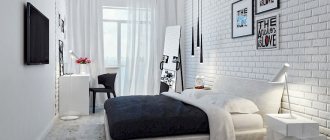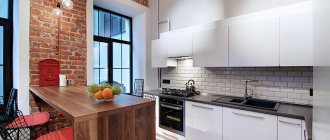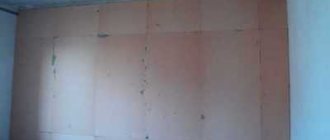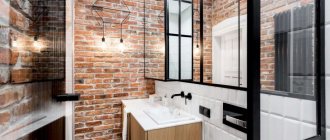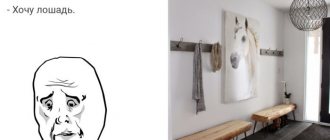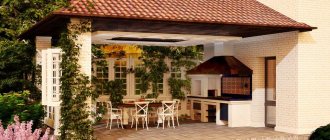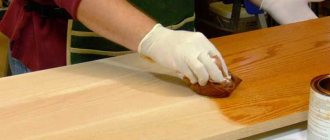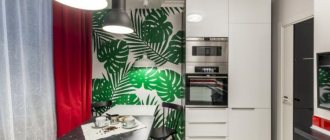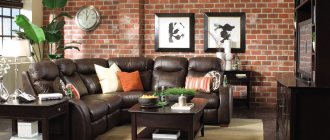With the help of decorative plaster you can create a wide variety of effects, from intricate to very simple. It also helps create the effect of concrete walls. Who would even think of creating a wall with such a dull pattern? In fact, decorative concrete plaster is popular in clubs, catering establishments, office buildings, as well as apartments designed in high-tech or loft style. And it is not concrete that is used, but decorative finishing that can imitate the most primitive and inconspicuous material, turning it into a work of art.
Painting walls to look like concrete in a loft style
Log in to use the function:
Material mixing
The first stage is kneading the material. Peter suggests that you need to knead in small portions, since the gypsum plaster “sets” quite quickly. We take a large bucket, pour a quarter of the volume of water into it and gradually add the plaster, stirring with a construction mixer or spatula. The mixture should resemble wet sand, it should not be homogeneous. There should be lumps! Otherwise, we will not achieve the desired effect.
Apply a layer to the wall
So that there are no “seams” on the wall, no transitions are visible, it is necessary to decorate the entire wall, without putting it off until the next day. For a person without experience, it is better to apply the plaster in small squares, using the entire prepared solution at a time.
To apply plaster to the wall you will need spatulas: two decorative and a standard one. We take the plaster with an ordinary spatula, place it on a decorative tool and use it to apply the material to the wall. The thickness of the applied layer is from 2 to 4 mm. Less is not possible, and there is no need for a thicker layer.
Application and further work with the material is a creative process. You cannot level the plaster for too long - the desired effect will disappear. The less you strive for systematic application of plaster, the more natural the end result is. After applying the plaster, leave it for 10 minutes.
Now you need to imitate the structure of concrete. To do this we need a bucket of water and a rag or sponge. Excess plaster must be constantly removed from the decorative spatula by wiping it with a damp cloth. It is not recommended to simply wash the spatula in water, as drops of water will remain on it, which should not fall on the wall.
To get the “damage effect”, you need to apply the decorative spatula with the back side to the wall and sharply tear it off, move it along the wall, creating chaos. Then, with minimal effort, smooth out the resulting “potholes.” If the unevenness is too deep, then you can correct them using an artistic palette knife.
After 20 minutes, when the plaster has set sufficiently, characteristic “scratches” can also be made. To do this, move the side of the spatula from top to bottom, pressing it with force. Peter warns that you need to “draw” in one direction throughout the entire work.
We consolidate the effect
After the plaster has completely dried (1-2 days), Peter recommends applying varnish to the wall. Why is it necessary to varnish the plaster? It is very vulnerable, easily absorbs moisture, and gets dirty. The varnish will allow you to care for this wall in the future, wash it, wipe it. In addition, the varnish will give the wall an additional decorative effect.
As a cheap alternative, you can replace the varnish with a primer. It will partially protect the wall, but will not allow you to wash it. It should also be taken into account that the primer can change the original color of the wall. By the way, you can add dye to the plaster to get any shade. Just remember that initially the plaster is not white, but gray. Don't forget this when mixing colors.
Material prepared with the support of
The Loft style originated when industrial premises began to be used for housing. This industrial interior is characterized by cold austerity, minimalism, open spaces with high ceilings and large windows. Having become popular, he moved from former workshops to private houses and ordinary apartments. In this article we will tell you how to use decorative plaster to imitate concrete, the imitation of which is often used in loft-style finishing.
Getting the seams in order
After all the preparations, there will definitely be voids in the seams; in addition, the removed bricks, if any, should be returned to their place.
For these purposes we will need putty. For interior work in rooms with little humidity, fugen gypsum putty is quite suitable; for exterior work or wet rooms, tile adhesive is well suited. Using putty, the bricks are inserted back, all voids and cavities in the seams are covered, holes and porous places on the brick should also be plugged. No trowels are required for this; just use your fingers and a frequently rinsed sponge. Having covered the seam with your finger, we then go through it with a sponge and remove everything unnecessary; anyone can do this operation! It is best to do this operation twice, be sure to miss something at once.
After caulking and drying the seams, it is useful to clean the whole thing with sandpaper and knock off all the burrs on the caulk.
What does it look like
A “loft” is characterized not only by concrete walls, but also by brick and metal surfaces. If you do not have a panel apartment, then the concrete surface can be imitated using decorative plaster. The texture is rough, the color of gray cement, but lighter colors can be made. This decor creates the effect of a working atmosphere in subdued cold colors.
Look at the photo to see what concrete plaster looks like in the interior:
To imitate a wall made of slabs, concrete rectangles are drawn on fresh plaster, and decorative elements are added in the form of rivets, mounting elements, etc. By the way, the texture of gray cement plaster is used not only in “loft”, but also in “high-tech”.
Additional work tips
- Trying to create the effect of a concrete slab rather than a plastered wall, you need to create a surface with chips and scratches, but at the same time it remains smooth. For this purpose, a regular washing brush is suitable, which is used to swab part of the surface. After this, you will need to smooth the drying surface with a trowel. The movements are multidirectional.
- For preliminary tinting of decorative plaster, dark gray pigments are usually used, which give the color of concrete.
- You need to work together if the volume of work is large. The first person applies the solution, and the second creates the pattern and carries out the grouting (correction of the pattern).
- You shouldn’t get carried away with the authenticity of concrete; after all, we are not making an exact copy of it, but creating a decorative coating.
Material
Let's consider what compositions are suitable for concrete finishing.
Microcement (microconcrete) .
This is a relatively new material used for plastering walls, floors, and also for creating kitchen countertops and splashbacks. Microcement is characterized by good plasticity, high adhesion, ease of application, but most importantly, strength. This thin (1-3 mm thick) decorative coating is given high strength and wear resistance, comparable to concrete, by a top layer of two-component epoxy varnish. Can be used for interior and exterior decoration. Decorative plaster .
The color of a gray concrete wall can be imitated with many finishing compounds, tinted with the appropriate color. But there are also brands specially made for plastering under concrete. For example, Art concrete from Decorazza. This is a ready-to-use acrylic water-dispersion solution with a mineral filler. Consumption is approximately 1 kg/m2 with a thickness of 1 mm. As an analogue of Art beton, one can name plasters Derufa, SAN MARCO and others. In addition to the main material for decoration, you will also need special wax, which is rubbed in a thin layer over the finished surface to give it gloss, tint and protect it from moisture. Many manufacturers of finishing coatings have this wax in their product line.
Cement mortar. Since cement is the basis of concrete, plaster mixed with it will naturally create the desired texture and color. In addition, this will be the cheapest way to decorate the walls in a loft style. But simple leveling cement-sand plaster has disadvantages. It is not intended to serve as a finish, so over time it will chip, wear, and crack. Cement plaster can be strengthened, for example, with varnish. But then the cost of finishing will increase; it’s easier to immediately use decorative plaster for concrete.
Tile adhesive. This material is based on cement and sand and contains adhesive polymers. Thanks to them, the glue acquires high strength. However, the grain size of such plaster is much larger than that of decorative plaster, so the surface will always be rough to the touch. It is unlikely to achieve the effect of polished concrete unless you mix tile adhesive with pure cement.
Where else is it used?
The loft style as an industrial modern trend is suitable for decorating both indoor and outdoor spaces, art spaces, as well as loft as a clothing style.
Now this style is gaining great popularity, so there are more and more accessories in clothing, furniture, even stationery, which allows you to fill more and more aspects of life in the industrial style. Loft is actively used in living rooms and bedrooms, kitchens and bathrooms of residential premises, as well as in workshops, studios, hotels, salons, gyms, office spaces and so on. Laconic minimalism allows you to create a stylish and interesting space for any purpose. In such an interior, you can add any posters, accessories, setting the tone and purpose, for example, an abundance of fresh flowers and botanical accessories will help create a fashionable interior for a flower salon.
Application technique
Before applying plaster to the walls, you should decide on its future texture.
It would seem, what to think about here, this is concrete? But even its simple surface can look different. For example, you can make an impression on a decorative layer, as if from wooden formwork. Or add fastening elements for concrete panels. Wall preparation includes:
Alignment . If you adhere to SNiP, then at least improved plastering is needed. The consumption of material and the appearance of the entire finish will depend on this. Plaster for concrete is applied in a thin layer and does not hide large defects in the walls, so their preparation is very important.
Cleaning . Dust and dirt should not impair the bond between the decorative material and the base.
Primer . To improve the adhesion (adhesion) of the plaster mortar, the walls need to be primed with contact primer with quartz sand. Suitable, for example, is “Betonokontakt” or analogues.
Selecting a working surface . Those sections of the wall that will not be plastered to look like concrete should be covered with film or masking tape. Door jambs and window slopes also need to be protected from contamination.
The technique of applying concrete-effect plaster is quite simple and anyone can do it themselves. Let's look at the work process step by step:
Consumption of plaster for concrete is 0.7-1.2 kg/m² (with a layer of 1 mm).
Drying time - 24 hours.
Sink and bathtub
The concrete bathtub looks impressive and weighty (and not only looks, its weight is really impressive - up to a ton). A completely concrete bathtub needs to be polished inside so that it is comfortable to sit in, and often impregnated with a special compound, otherwise fungus is likely to grow in the pores of the material. Conclusion: if you want such a concrete miracle in the bathroom, it is better to limit yourself to an external frame with a regular bathtub inserted inside.
With the sink, the situation is a little simpler, because... there is no need to sit in it. However, the problem of heavy weight becomes even more pressing.
Loft style wall decoration
There are many ways to decorate walls in a loft style - from concrete or brick surfaces without finishing to the use of modern finishing materials. No matter what option is used for finishing, in the end you can always achieve excellent results, especially if you use the services of specialists.
It should be remembered that despite the inherent brutality, a loft is always the self-expression of an innovative spirit and thoughtful harmony in every detail, therefore the design of walls requires a special, creative approach.
How to make it yourself
Few people know, but it is quite possible to make loft-style bricks, which are popular nowadays, with your own hands. This will not take much time and effort.
It will be very good if the walls in your home are initially made of brick. In this case, you will only need to wipe all existing cracks, as well as clean the bricks from various stains and contaminants. It will be necessary to get rid of dust and plaque. Next, all that remains is to cover the masonry with paint or varnish.
This is done like this:
- water-based formulations are used;
- dilute the coloring composition with water and mix well;
- water must be added until the mixture acquires a translucent tone;
- Next, each brick must be treated with the resulting composition using a sponge;
- during the impregnation process, the bricks will be painted;
- there is no need to treat the entire base at once - start with a small area;
- After completing all work, be sure to wait until the paint/varnish hardens.
A beautiful and common choice of finish is imitation made from a plaster mixture.
This method has the following advantages:
- inexpensive;
- is environmentally friendly;
- does not take up useful space in the room;
- available for self-administration.
Materials and tools you will need:
- separate container for diluting the solution;
- special tile adhesive and plaster mixture;
- masking tape;
- narrow and wide spatulas;
- rules and level (it is better to take a laser or bubble).
First, you will need to prepare the walls in the room for future decorative decoration. The surfaces must be cleaned of the previous wallpaper, and all differences must be smoothed out with sandpaper. To ensure that the mixture adheres reliably, before laying the mortar, you should treat the walls with a primer using a roller or brush.
Now you need to mark the wall using masking tape. The usual parameters of a brick are 25x6.5 cm, and the indentation is 1.5 cm. First you need to paste over the horizontal stripes, and then proceed to the vertical ones. To prepare the solution, we use glue and plaster in proportions of 50x50. After this, apply the prepared composition with a spatula (this can also be done manually, if desired). Try not to touch the ends of the tape.
After applying the composition, the tape between the individual “bricks” must be removed. To give the masonry a more natural shape, you should use a chisel or a tablespoon. Then you need to clean the surface with sandpaper. Next, you will need to prime both the bricks and the seams between them.
If treating walls with plaster mixtures and paint coatings does not appeal to you, then you can turn to another common way to bring a brick wall into the interior - hanging wallpaper that imitates brickwork. You won’t have to regularly maintain this surface, spending extra money. You will just need to wipe off dust from time to time using a slightly damp cloth.
However, it must be borne in mind that in most cases such surfaces immediately reveal their unnaturalness. Their appearance is much inferior to natural stonework, especially if the print on the canvas itself is mediocre. There are often cases when such finishing reduces the cost of the interior, sometimes making it ridiculous. That is why wallpaper for brickwork needs to be chosen especially carefully so as not to spoil the decor in the house/apartment.
Without cladding
An unlined brick or concrete wall is a classic option that stands at the origins of the style.
Brick
Natural clay brick with all its defects, such as dark heat stains and light efflorescence, creates a special atmosphere that is incomparable with artificial finishes. Exposed brickwork looks especially stylish in the hallway, kitchen and living room, and sometimes such a wall can become an accent in the interior design of even a bedroom.
Recently, the use of the loft style in the design and creation of the interior of your apartment has become extremely popular, and therefore we bring to your attention a selection of interiors in the loft style:
Brick loft-style design should not be associated with unfinished renovations. As a rule, if the masonry was originally planned for plaster, builders do not pay attention to aesthetics. The seams have not been finished, a clear geometric sequence has not been observed. For masonry red brick, it is advisable to make such a decision at the construction stage.
On the practical side, an uncoated surface can have a number of disadvantages. Firstly, masonry brick is quite hygroscopic and it will be difficult to clean it from grease stains and other contaminants. Secondly, when using a weak solution, the seams begin to crumble. To eliminate such shortcomings, it is recommended to treat the surface with a primer or coat it with transparent acrylic varnish. Visually this will not be noticeable, and care will become much easier.
Concrete
A concrete wall in a loft interior looks no less attractive if you approach this decision professionally. In panel buildings, this is the most inexpensive option, since the surfaces are relatively smooth and require virtually no modification.
At the same time, it is not worth leaving everything without finishing, because loft, first of all, implies a combination of incompatible trends, and initially - the creation of comfort in industrial buildings not intended for housing. The concrete wall should be highlighted as a classic brutalist element, balanced by the overall background of the interior environment.
Concrete is often painted. Unlike standard painting of stone surfaces, it is necessary to exclude idealism. One of the easiest ways is to use water-based paint without prior primer. The paint, in this case, will not lie flat, but in spots, creating a special charm of the style. In terms of tonality, you should stick to canonical colors, avoiding bright tones and contrasts.
White brick
Basically, everyone associates a loft with red brick walls, and preferably with pieces of cement, as if they decided not to finish the renovation and live just like that. But white color for brick is as natural as red. It does not stand out as much and attracts less attention, but at the same time it is less authentic and does not retain the atmosphere of factory premises. A combined option is also possible - leaving one of the walls according to the canons of the style.
White brick for the apron, and the walls are red
You don't have to use real brick. You can buy “brick” blanks or a special roller in the store to create the appropriate texture. This is a good option if you are doing a purely cosmetic renovation and do not want to “disassemble” the wall.
An all-white bedroom will look beautiful: a wall decorated with white brick, a snow-white ceiling, bedside tables, a chest of drawers, a desk and a light beige bed. Floors can be covered with natural wood of the appropriate species. Additionally, the interior will be decorated with black and white paintings and some unusual lamps.
White brick in the bedroom
Glass blocks
This is a fairly common material in both civil and industrial construction. In loft, glass blocks are used not only as a translucent structure, but also as a decorative element of the wall structure. Considering that the style includes large windows, a wall or part of it made of glass blocks can become the main style accent for a room without windows.
Features and differences
This style is urban and industrial in origin. It became popular in the United States last century, when famous designers began to use the premises of abandoned factories and factories to decorate their art studios and apartments.
The main features of the style will be:
- There are no partitions in the room, the entire space is an open studio; Only the bathroom and toilet are designated as a separate room.
- Zoning is carried out using screens, shelves and racks, different floor coverings and color schemes on the walls.
- Industrial “rough” finishing materials are concrete, brick, metal, glass and wood. Decorative coverings, wallpaper, alignment of walls and floors are contrary to style.
- Windows should let in maximum light; do not cover them with thick curtains.
- A combination of modern furniture and old, antique items is used.
At the same time, such an interior is diluted with textiles, cozy furniture and accessories, which allows it to be used in bedrooms and living rooms.
Finished walls
The use of finishing materials in loft design often includes non-standard solutions. Materials for exterior finishing, flooring and even exclusive home-made solutions are used for cladding. At the same time, natural materials such as stone, wood, metal and glass are welcome in the loft. The use of plastic is virtually eliminated. Although in decorative elements, as an alternative to glass, transparent plastic may be found.
If desired and possible, the interior can be decorated in a loft style with your own hands; you will learn how to do this in the article:
Under the brick
Imitation brickwork is the most common type of finishing. For this, gypsum or clinker tiles are used. A large selection of modern materials makes it possible to create cladding to suit every taste. For example, clinker tiles allow you to perfectly imitate neat masonry, and gypsum tiles, stylized as brick, embody the idea of an aged wall.
Another method was the non-standard technology of imitating brick using tile adhesive. This is manual painstaking work, not regulated by any regulatory document. In other words, this is almost a sculptural work, when the texture is created directly on the wall.
Two methods are examples of such work. The first is when the seams are cut using wet mortar applied to the wall surface. The second one involves preliminary gluing of adhesive tape in the seam configuration. Once the mortar is applied, it comes off, dividing the plaster into rectangular sections like brickwork.
Tree
The most common materials for cladding are wooden lining or the modern block house. However, such options are more typical of the Scandinavian style. A loft must necessarily have a flaw and inherent negligence.
One of the variations of wall decoration with wood was cladding with simple edged boards without groove joints. Even the heads of the nails will be visible in this case, giving the design a moderate brutalism. Unlike standard materials, here it becomes possible to create an exclusive design. By varying the thickness of the boards, the cleanliness of the polishing, the width of the planks and seams, you can always create your own unique version of the cladding.
In addition, by using certain stains, you can imitate valuable noble wood species. To make this method more practical, that is, the surface is easier to clean and does not react to humidity, the boards can be coated with stained glass varnish, visually preserving the structure of natural wood.
A simpler way to finish wood is to imitate it using laminate. Although this material is a floor covering, today you can find many examples when it is laid on the wall. In addition, you can always choose a laminate with a rough texture. In this case, the material will not be subjected to abrasive loads, so you can save on its class and quality of locking connections.
Panels are also used for wall decoration; they are becoming an increasingly popular facing material. Working with them is quite simple; self-installation is possible, provided you have an initial level of training in repair work in general:
Metal
At first glance, this is a rather avant-garde solution even for loft, but if you use it in the right place, it will turn out not only stylish, but also practical.
Metal finishing has become an excellent alternative to tiles and is more often used:
For those who missed the previous article, loft-style bathroom, you can follow the link below:
Sometimes metal is combined with stone or wood, covering only part of the wall.
Several options can be used here as a material: matte or mirror stainless steel sheets, as well as corrugated sheets of aluminum or stainless steel. A more extravagant solution was the use of PVL - expanded metal sheets. Traditionally, PVL is used as the base of steps, porches, and sometimes basement gratings. A black mesh sheet can be used as partitions for zoning a room. PVL partitions will go well with stone finishing of the main surfaces.
Plaster
Plastering is one of the most inexpensive and easiest ways to implement the loft style in a wide variety of rooms. Initially, in industrial buildings, there were no special requirements for plane deviations in terms of the quality of the plaster layer. The wall turned out to be unsmoothed, had unevenness, roughness, scratches and small depressions. With the formation of loft, this plaster became quite popular. Today, a lot of ready-made mixtures are offered for sale to obtain a similar texture.
We draw your attention to decorative plaster of walls, which occupies a leading place among finishing materials. Complex application technology, a large selection and variety of types can make life difficult for the average person. Specialists will professionally perform any task:
Lime plaster
Not so long ago, the widely used composition of a mixture of sand, cement and lime is now becoming a thing of the past. They have been replaced by more durable compounds that do not crumble or crumble. Despite many shortcomings, lime plaster has been preserved in old houses to this day. Plus it holds up well.
In addition, the quality of its installation is quite consistent with loft, which can be used in design on a limited budget. Of course, it is not recommended to leave such a coating in its original form, as it will crumble and in most cases become affected by fungus. Initially, the old plaster needs to be treated with an antifungal compound, and then with a deep penetration primer. After drying, the wall can be painted with water-based paint, giving it a darker shade.
makes tasteful repairs in Moscow and the region at a competitive price and a 5-year guarantee:
Modern materials
When repairing from scratch, you can use both compositions for interior and exterior plaster for finishing. You can give the coating the desired texture using a special roller. Bark beetle plaster or latex compounds with coarse chips look original indoors.
The latest fashion has become plastering with tile adhesive. The solution is not entirely standard, since the stickiness and plasticity of the composition causes some difficulties when smoothing, but the surface acquires the unevenness characteristic of loft. As a result, such a wall becomes an excellent basis for graffiti, which will become the highlight of the style.
Brick wall - imitation
The simplest and most budget-friendly option for simulating a brick wall is wallpaper with a brick print. This surface is easy to care for - you can simply wipe it with a damp cloth. The disadvantage is that the surface is unnatural, and the end result does not look very attractive.
Another common option is decorative brick-like stone. The surface of this stone is covered with glaze, so with proper care it will last for a long time. And this coating looks very natural, but in terms of budget this option is very expensive.
The most optimal and beautiful finishing option is an imitation brick wall made of plaster.
Advantages of this method:
- no large financial costs required
- environmental friendliness - the plaster contains no harmful substances
- the space will not decrease - the layer is quite thin
- you can handle it on your own, there is no need to call specialists
Materials and tools:
- bath - for administering the solution
- tile adhesive and plaster
- masking tape
- wide and narrow spatulas
- construction rule and laser level
Decoration
The most trivial solution is to paint the loft walls. When maintaining style, you should choose soft colors - gray, pale red, brown or blue. For small rooms it is better to choose lighter shades, while spacious rooms are in perfect harmony with dark tones. There is no need to be afraid to experiment and add a little brutality by applying paint unevenly, with rough strokes.
The exclusive decor of the loft walls is of no small importance. These could be designer lamps, various intricate decoration elements with clear geometric shapes, or paintings in an avant-garde style. You can install LED backlighting by placing the light source below. As for the incidence of light on the surface, this will emphasize the texture and add a significant amount of romanticism.
The best option would be to turn to professionals, presenting them with your vision. Designers will create a design project for the interior of the apartment, and real specialists will turn the idea into reality, taking into account all the wishes of the customer.
Source
